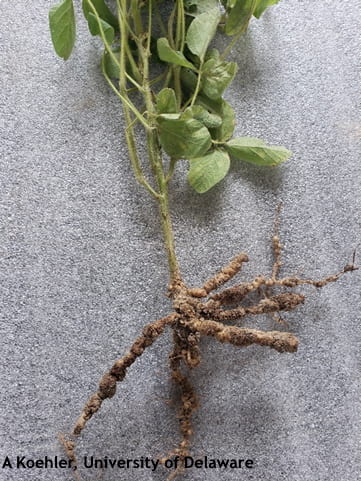Alyssa Koehler, Extension Field Crops Pathologist; akoehler@udel.edu
Root knot nematodes (RKN) are plant pathogenic roundworms that live in the soil. The southern root-knot nematode (Meloidogyne incognita) is common across Delaware and can be yield limiting to soybeans, lima beans, snap beans, watermelons, cantaloupes, and other cucurbits. With such a wide host range, RKN populations can become very high, turning into chronic pests within fields. As the name implies, root knot nematodes cause large, irregular growths, called galls, on roots (Figure 1). Root knot nematodes overwinter in the soil as eggs. When susceptible plants are planted, root exudates will trigger hatching and juvenile nematodes will move towards the root tip to establish a feeding site (gall). The nematode remains attached to the root and will lay eggs that hatch and infect more roots as long as soil temperatures are conducive. The lifecycle from egg to reproduction can be as short as 21-28 days allowing multiple generations to occur within a single growing season. Symptoms from RKN include stunting, reduced vigor, and wilting that can often go overlooked. To determine if plants are infected with RKN, roots must be inspected for galls, knots, or swellings. In soybeans, galls can distinguished from beneficial nitrogen fixing bacterial nodules by splitting open a structure. When split, galls are colorless to milky white inside, while nodules are pink. Nematode damage often appears patchy within the field and plants are typically most susceptible to damage when at the seedling stage. Soil samples for nematode analysis can be collected from areas where damage has been observed in the past or areas where nematodes are suspected. The Koehler lab is conducting nematode surveys across the state, if you would like to be added to the survey, please contact akoehler@udel.edu.
Management of RKN is best achieved prior to planting. Preventative strategies can include rotation with small grains, variety selection when available, certain cover crops, using transplants free of nematodes, nematicides, and soil fumigants. Research has shown some reduction in nematode populations following soil incorporation of large amounts of organic matter, such as sorghum-sudangrass green manure in combination with poultry compost. Some rapeseed cultivars, such as ‘Dwarf Essex’ and ‘Humus’ also are suppressive to nematode populations. In vegetable production, preplant fumigants can include Telone or Vapam. Once a crop has been established, management options are less effective. Vydate L can be applied to cucurbits at 0.5 to 1.0 gal/A and incorporated into top 2-4 inches of soil, or at 2.0 to 4.0 pt/A applied 2 weeks after planting and repeated 2-3 weeks later. Velum Prime, which is in a different chemical class, can be applied at 6.5 to 6.84 fl oz/A through drip irrigation at 5-day intervals (see label for details). Symptoms become most apparent when plants are under stress, providing adequate nutrition and moisture to reduce plant stress can somewhat mitigate the damage observed.

